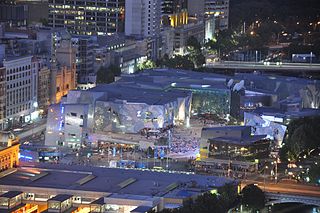
Federation Square is a venue for arts, culture and public events on the edge of the Melbourne central business district. It covers an area of 3.2 ha at the intersection of Flinders and Swanston Streets built above busy railway lines and across the road from Flinders Street station. It incorporates major cultural institutions such as the Ian Potter Centre, Australian Centre for the Moving Image (ACMI) and the Koorie Heritage Trust as well as cafes and bars in a series of buildings centred around a large paved square, and a glass walled atrium.
The Melbourne Convention and Exhibition Centre (MCEC), colloquially referred to as Jeff's Shed, is a group of three adjacent buildings next to the Yarra River in South Wharf, an inner-city suburb of Melbourne, Victoria, Australia. The venues are owned and operated by the Melbourne Convention and Exhibition Trust.

Justine Clark is an architectural editor, writer, speaker and researcher, based in Melbourne, Australia. She is the editor of Parlour, a former editor of Architecture Australia, and co-author of Looking for the Local: Architecture and the New Zealand Modern.
ACMI, formerly the Australian Centre for the Moving Image, is Australia's national museum of screen culture including film, television, videogames, digital culture and art. ACMI was established in 2002 and is based at Federation Square in Melbourne, Victoria.
Sir Roy Burman Grounds was an Australian architect. His early work included buildings influenced by the Moderne movement of the 1930s, and his later buildings of the 1950s and 1960s, such as the National Gallery of Victoria and the adjacent Victorian Arts Centre, cemented his legacy as a leader in Australian architecture.

Dr Norman Kingwell Day is an architect, educator, and writer.

Peter Russell Corrigan was an Australian architect and was involved in the completion of works in stage and set design.
The Melbourne City campus of the Royal Melbourne Institute of Technology is located in the city centre of Melbourne in Victoria, Australia. It is sometimes referred to as "RMIT City" and the "RMIT Quarter" of the city in the media.

Storey Hall, located at 342–344 Swanston Street in Melbourne, Australia, is part of the RMIT City campus of the Royal Melbourne Institute of Technology. It consists of a grand meeting hall constructed in 1887, extended and renovated in 1996, providing a large upper hall, the lower hall as home to RMIT Gallery First Site, and a range of lecture theatres and seminar rooms.
The Melbourne Arts Precinct is home to a series of galleries, performing arts venues and spaces located in the Southbank district of Melbourne, Victoria, Australia. It includes such publicly-funded venues as Arts Centre Melbourne, National Gallery of Victoria and Southbank Theatre, along with various offices and training institutions of arts organisations.
Ivan Rijavec is an Australian architect.
Kerstin Thompson is an Australian architect, born in Melbourne in 1965. She is the principal of Kerstin Thompson Architects (KTA), a Melbourne-based architecture, landscape and urban design practice with projects in Australia and New Zealand. She is also Professor of Design at the School of Architecture at Victoria University of Wellington, New Zealand, and adjunct professor at RMIT University and Monash University.

RMIT Building 8 is an educational building, part of RMIT University's City campus in Melbourne, Victoria. It is located at 383 Swanston Street, on the northern edge of Melbourne's central business district.

The RMIT Design Hub is a research, archive, exhibition, and studio space of the Royal Melbourne Institute of Technology in Melbourne, Australia located on the historic Carlton & United Breweries site.
Searle X Waldron is an Australian architecture firm based in St Kilda, Melbourne. It is an emerging firm co-founded by Nick Searle and Suzannah Waldron in 2007. The firm focuses on projects ranging from small scale residential to larger scale urban master-planning. Some of their notable projects and design competitions include the MoCAPE and Art Gallery of Ballarat Annexe which have managed to attain various awards from the Australian Institute of Architects, including the 2012 Colorbond Award for Steel Architecture and 2012 Architecture Award for Public Architecture Alteration & Additions. Their designs have been exhibited across Australia and throughout Asia and Europe.
Shelley Jane Penn is a Melbourne-based award-winning architect, educator, urbanist and built environment advocate.

Eli (Elisabetta) Giannini AM is an Australian architect and director of MGS Architects in Melbourne. Giannini completed her architectural undergraduate studies at RMIT University in 1983 and Master of Design (Thesis) in 1903, entitled ‘Metro-scape’. Soon after her undergraduate studies in 1989, she joined MGS Architects with Robert McGauran and Mun Soon. In 2002 she was selected as President of the Victorian Chapter of the Australian Institute of Architects, a position occupied until 2004.
Harriet Edquist is an Australian historian and curator, and Professor Emerita in the School of Architecture and Urban Design at RMIT University in Melbourne. Born and educated in Melbourne, she has published widely on and created numerous exhibitions in the field of Australian architecture, art and design history. She has also contributed to the production of Australian design knowledge as the founding editor of the RMIT Design Archives Journal and is a member of the Design Research Institute at RMIT University.
Kirsten Bauer is an Australian landscape architect notable for her contributions to practice, education and research. She is a Director of Aspect Studios in Melbourne.

The Victorian Architecture Medal is the highest honour awarded annually by the Victoria Chapter of the Australian Institute of Architects (AIA) and has been awarded 38 consecutive times since 1987. The Medal was originally known as the ‘Street Architecture Medal’ introduced by the Royal Victorian Institute of Architects (RVIA) in 1929 as an award for the design of a building of exceptional merit. Buildings were judged on their "urban propriety and architectural etiquette; the building had to front a street, road, square or court" and with a requirement of being publicly accessible, thereby excluding residential and private commissions.








